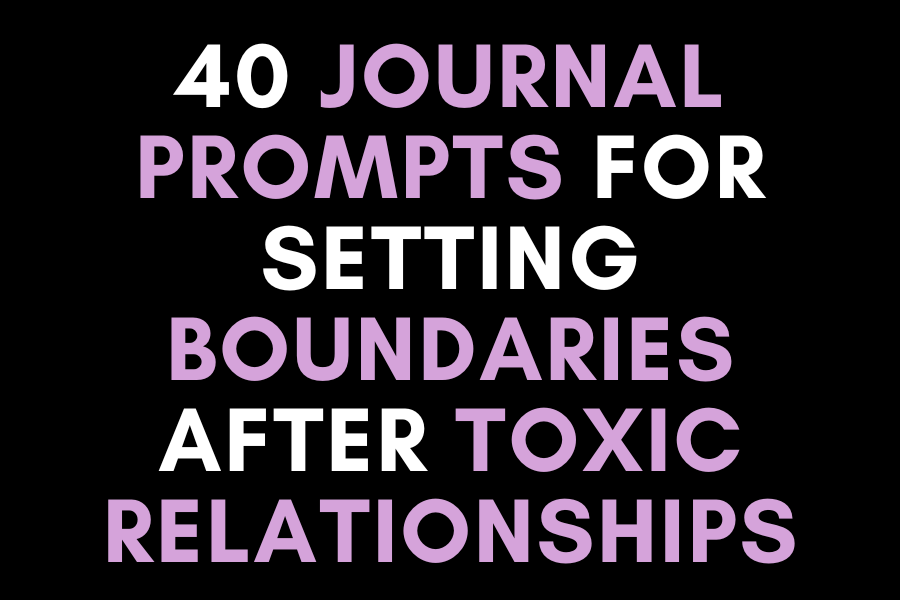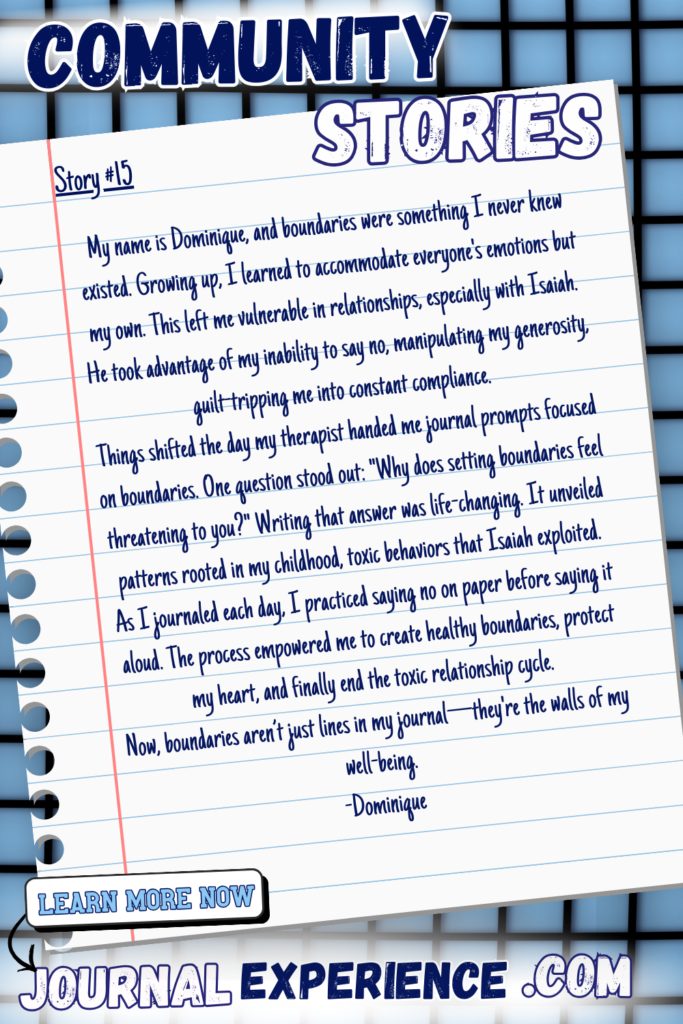Boundaries are the foundation of emotional safety. For those recovering from toxic relationships, setting boundaries is not just a skill—it’s an act of healing. After being conditioned to overextend, tolerate disrespect, or suppress your needs, reclaiming your space can feel both empowering and unfamiliar.

Boundaries help define what is okay and what isn’t. They protect your energy, reinforce your values, and help you build relationships rooted in mutual respect. Yet, many survivors struggle to even recognize what their boundaries are, let alone communicate or enforce them. That’s where journaling becomes a powerful ally.
Journaling helps you clarify your values, validate your needs, and explore where your limits begin and end. The prompts in this post are designed to walk you through the boundary-setting journey—from identifying what makes you feel safe to practicing the confidence to stand firm in your truth.
Doesn’t matter if you’re setting boundaries with others or simply learning how to say yes to yourself, this post offers guided support for every step of the process.
Guided Journal Prompts for Boundary Work and Recovery
Prompts to Define Personal Boundaries
Before you can set boundaries, you have to know what they are. These prompts are designed to help you identify the values, emotions, and personal space you want to protect. Naming your boundaries is the first step to honoring them. For many survivors of toxic relationships, boundaries were blurred or punished, making it difficult to know where your “yes” ends and your “no” begins. These reflections will help you gently explore what it means to protect your energy without guilt and to define yourself without apology.
Journal Prompts
- What makes me feel emotionally and physically safe?
- In what situations do I feel most respected and heard?
- Where in my life have I allowed too much access to my energy?
- What does a healthy boundary look like to me?
- How do I know when a boundary is being crossed?
- What needs do I often ignore that deserve more protection?
- Where in my life do I feel drained, and what might be missing?
- What behaviors from others are no longer acceptable to me?
- What does it mean to give myself permission to say “no”?
- What is one boundary I’m ready to define and begin practicing?
Clarity Reminder
You are allowed to take up space, protect your peace, and say no without guilt.
Exploring Past Experiences with Weak Boundaries
Looking back on times when boundaries were weak or ignored can be painful—but it can also bring powerful insight. These prompts help you explore where your boundaries were violated and why, so you can begin the process of reclaiming your power without judgment. Understanding your patterns doesn’t mean blaming yourself—it means honoring the part of you that did what it needed to survive. With compassion, you can begin rewriting those stories and create a life that supports your emotional safety.
Journal Prompts
- When have I felt taken advantage of, and how did I respond?
- What made me ignore my own discomfort in past situations?
- How did I learn to tolerate disrespect or emotional neglect?
- What messages was I taught about putting others before myself?
- What did it cost me emotionally to avoid conflict or keep the peace?
- When have I abandoned my own needs to please someone else?
- How did I feel when I said “yes” when I really wanted to say “no”?
- What role did fear play in my inability to set limits?
- What would I tell my younger self about self-protection and boundaries?
- What relationships felt one-sided, and what did I need that I didn’t get?
Insight Reflection
Revisiting these moments isn’t about blame—it’s about clarity. You’re learning how to honor your truth moving forward.
Strengthening Boundaries Through Journaling
Practicing boundaries in writing can help you build the confidence to use them in real life. For many survivors, speaking up for their needs can feel intimidating or unsafe. Journaling allows you to rehearse these moments on your own terms, free from judgment or pressure. These prompts help you develop clear language, visualize real-world scenarios, and reflect on how it feels to stand firm in your needs. The more you explore and write about boundary-setting, the easier it becomes to embody that confidence in everyday life.
Journal Prompts
- What would I say to someone if I felt fully confident in protecting my energy?
- What does it feel like in my body when I’m holding a boundary?
- Write a response to someone who oversteps your boundaries—kind but firm.
- What would it look like to choose peace over people-pleasing?
- In what areas of life do I want to become more assertive?
- How does it feel to be my own protector?
- Write a script for a boundary I need to communicate this week.
- How do I want to handle pushback or guilt when I set a boundary?
- What fears do I have about being “too much” or “too distant”?
- What empowers me to stand in my truth, even when it’s uncomfortable?
Confidence Practice
Use your journal to rehearse conversations before they happen. Your words are practice for living in alignment.
Self-Reflection Prompts to Sustain Your Growth
Maintaining boundaries is an ongoing process. It requires regular check-ins, honest self-assessment, and a willingness to grow through discomfort. These prompts support your ability to reflect on your progress, hold yourself accountable, and build a relationship with yourself that’s rooted in self-respect. Boundary work isn’t just about others—it’s also about how you honor your needs when no one is watching. Use these reflections to continue nurturing the version of you that chooses peace, balance, and emotional safety.
Journal Prompts
- What boundaries do I still struggle to uphold, and why?
- How can I hold myself accountable with compassion?
- What does self-respect look like in my daily actions?
- How do I want to feel in the spaces I choose to be in?
- What does a balanced life with strong boundaries look like to me?
- How do I care for myself after a difficult boundary-setting moment?
- What signs tell me I need to reestablish a boundary?
- What’s something I’ve recently done that shows I’m growing?
- How can I celebrate my boundary wins, no matter how small?
- What does it mean to love myself through the discomfort of growth?
Overview
Healing happens in small, daily choices. Boundaries are not a destination—they’re a practice of returning to yourself.
Your boundaries are not walls—they’re your liberation. Each prompt you explore is an invitation to trust yourself, speak up, and choose peace over people-pleasing. Boundaries give shape to your healing and help define what a safe, supportive life looks like on your own terms.
Journaling helps you meet yourself with truth, clarity, and compassion—every single day. It reinforces your right to say no, to walk away, and to protect the version of you who’s learning how to feel safe again. With time and practice, you will no longer just set boundaries—you’ll live them. And that’s where your freedom begins.
Explore boundary-setting journals and weekly writing support exclusively inside The Journal Experience. Become A Member to access guided prompts, emotional healing tools, and a community dedicated to helping you reclaim your space and power after toxic relationships.
Subscribe to TJE’s Newsletter today and receive thoughtful reminders that help you stay committed to your healing and self-respect.


